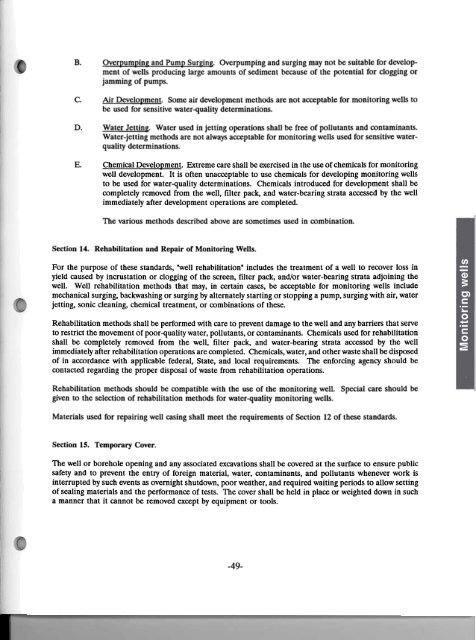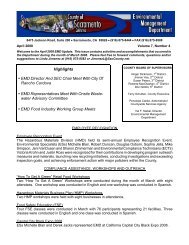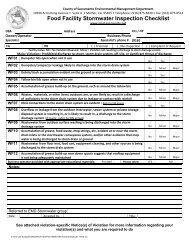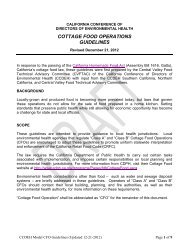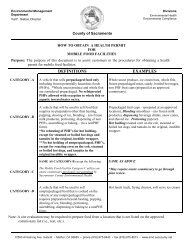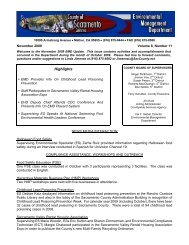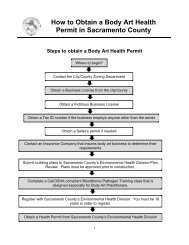California Water Well Standards, DWR Bulletin 74 ... - County of Glenn
California Water Well Standards, DWR Bulletin 74 ... - County of Glenn
California Water Well Standards, DWR Bulletin 74 ... - County of Glenn
- No tags were found...
Create successful ePaper yourself
Turn your PDF publications into a flip-book with our unique Google optimized e-Paper software.
B. c. E.Over~um~ing and Pum~ Surging. Overpumping and surging may not be suitable for development<strong>of</strong> wells producing large amounts <strong>of</strong> sediment because <strong>of</strong> the potential for clogging orjamming <strong>of</strong> pumps.Air Devel°l!ment. Some air development methods are not acceptable for monitoring wells tobe used for sensitive water-quality determinations.D. <strong>Water</strong> Jetting. <strong>Water</strong> used in jetting operations shall be free <strong>of</strong> pollutants and contaminants.<strong>Water</strong>-jetting methods are not always acceptable for monitoring wells used for sensitive waterqualitydeterminations.Chemical Develo~ment. Extreme care shall be exercised in the use <strong>of</strong> chemicals for monitoringwell development. It is <strong>of</strong>ten unacceptable to use chemicals for developing monitoring wellsto be used for water-quality determinations. Chemicals introduced for development shall becompletely removed from the well, filter pack, and water-bearing strata accessed by the wellimmediately after development operations are completed.The various methods described above are sometimes used in combination.Section 14. Rehabilitation and Repair <strong>of</strong> Monitoring <strong>Well</strong>s.For the purpose <strong>of</strong> these standards, "well rehabilitation" includes the treatment <strong>of</strong> a well to recover loss inyield caused by incrustation or clogging <strong>of</strong> the screen, filter pack, and/or water-bearing strata adjoining thewell. <strong>Well</strong> rehabilitation methods that may, in certain cases, be acceptable for monitoring wells includemechanical surging, backwashing or surging by alternately starting or stopping a pump, surging with air, waterjetting, sonic cleaning, chemical treatment, or combinations <strong>of</strong> these.Rehabilitation methods shall be performed with care to prevent damage to the well and any barriers that serveto restrict the movement <strong>of</strong> poor-quality water, pollutants, or contaminants. Chemicals used for rehabilitationshall be completely removed from the well, filter pack, and water-bearing strata accessed by the wellimmediately after rehabilitation operations are completed. Chemicals, water, and other waste shall be disposed<strong>of</strong> in accordance with applicable federal, State, and local requirements. The enforcing agency should becontacted regarding the proper disposal <strong>of</strong> waste from rehabilitation operations.Rehabilitation methods should be compatible with the use <strong>of</strong> the monitoring well. Special care should begiven to the selection <strong>of</strong> rehabilitation methods for water-quality monitoring wells.Materials used for repairing well casing shall meet the requirements <strong>of</strong> Section 12 <strong>of</strong> these standards.Section 15. Temporary Cover.The well or borehole opening and any associated excavations shall be covered at the surface to ensure publicsafety and to prevent the entry <strong>of</strong> foreign material, water, contaminants, and pollutants whenever work isinterrupted by such events as overnight shutdown, poor weather, and required waiting periods to allow setting<strong>of</strong> sealing materials and the performance <strong>of</strong> tests. The cover shall be held in place or weighted down in sucha manner that it cannot be removed except by equipment or tools.-49-


